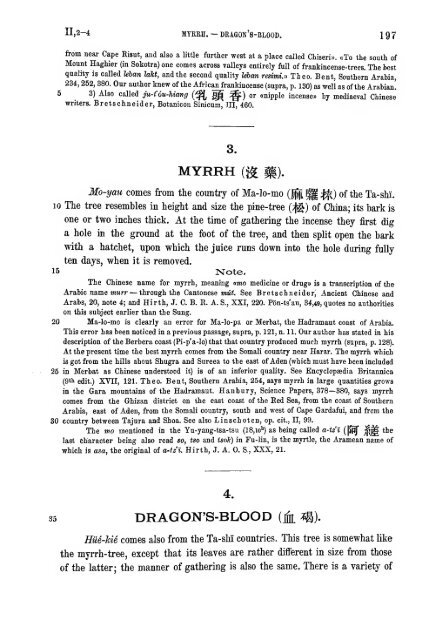Chau Ju-Kua - University of Oregon Libraries
Chau Ju-Kua - University of Oregon Libraries
Chau Ju-Kua - University of Oregon Libraries
You also want an ePaper? Increase the reach of your titles
YUMPU automatically turns print PDFs into web optimized ePapers that Google loves.
II>2-4 MTEEn. — dkagon's-blood. 197<br />
from near Cape Risut, and also a little further west at a place called Chiseri». «To the south <strong>of</strong><br />
Mount Haghier (in Sokotra) one comes across valleys entirely full <strong>of</strong> frankincense-trees. The best<br />
quality is called leban Idkt, and the second quality Ulan resimln Theo. Bent, Southern Arabia,<br />
234, 252, 380. Our author knew <strong>of</strong> the African frankincense (supra, p. 130) as well as <strong>of</strong> the Arabian.<br />
3) Also called ju-fou-hiang (^ |^ ^) or anipple incenses by mediaeval Chinese<br />
writers. Bretschn eider, Botanicon Sinicum, III, 460.<br />
3.<br />
MYRRH ii^ ^).<br />
Mo-yau comes from the country <strong>of</strong> Ma-lo-mo (0 R|| j^) <strong>of</strong> the Ta-shi.<br />
10 The tree resembles in height and size the pine-tree (7^) <strong>of</strong> China; its bark is<br />
one or two inches thick. At the time <strong>of</strong> gathering the incense they first dig<br />
a hole in the ground at the foot <strong>of</strong> the tree, and then split open the bark<br />
with a hatchet, upon which the juice runs down into the hole during fully<br />
ten days, when it is removed.<br />
15 Note,<br />
The Chinese name for myrrh, meaning «mo medicine or drug» is a transcription <strong>of</strong> the<br />
Arabic name mwrr — through the Cantonese mu*. See BretschneiderJ Ancient Chinese and<br />
Arabs, 20, note 4; and Hirth, J. C. B. R. A. S., XXI, 220. Pon-ts'au, 34,49, quotes no authorities<br />
on this subject earlier than the Sung.<br />
20 Ma-Io-mo is clearly an error for Ma-lo-pa or Merbat, the Hadramaut coast <strong>of</strong> Arabia.<br />
This error has been noticed in a previous passage, supra, p. 121, n. 11. Our author has stated in his<br />
description <strong>of</strong> the Berbera coast (Pi-p'a-lo) that that country produced much myrrh (supra, p. 128).<br />
At the present time the best myrrh comes from the Somali country near Harar. The myrrh which<br />
is got from the hills about Shugra and Sureea to the east <strong>of</strong> Aden (which must have been included<br />
25 in Merbat as Chinese understood it) is <strong>of</strong> an inferior quality. See Encyclopaedia Britannica<br />
(9* edit.) XVII, 121. Theo. Bent, Southern Arabia, 254, says myrrh in large quantities grows<br />
in the Gara mountains <strong>of</strong> the Hadramaut. Hanbury, Science Papers, 378—380, says myrrh<br />
comes from the Ghizan district on the east coast <strong>of</strong> the Bed Sea, from the coast <strong>of</strong> Southern<br />
Arabia, east <strong>of</strong> Aden, from the Somali country, south and west <strong>of</strong> Cape Gardafui, and from the<br />
30 country between Tajura and Shoa. See also Linschoten, op. cit., II, 99.<br />
The mo mentioned in the Yu-yang-tsa-tsu (18,io^) as being called a-tz'i ([JfH" -^^ the<br />
last Character being also read so, tso and tsoJc) in Fu-lin, is the myrtle, the Aramean name <strong>of</strong><br />
which is asa, the original <strong>of</strong> a-tz"i. Hirth, J. A. 0. S., XXX, 21.<br />
35 DRAGON'S-BLOOD (j^ ^).<br />
4.<br />
Hiie-Jcie comes also from the Ta-shi countries. This tree is somewhat like<br />
the myrrh-tree, except that its leaves are rather different in size from those<br />
<strong>of</strong> the latter; the manner <strong>of</strong> gathering is also the same. There is a variety <strong>of</strong>

















